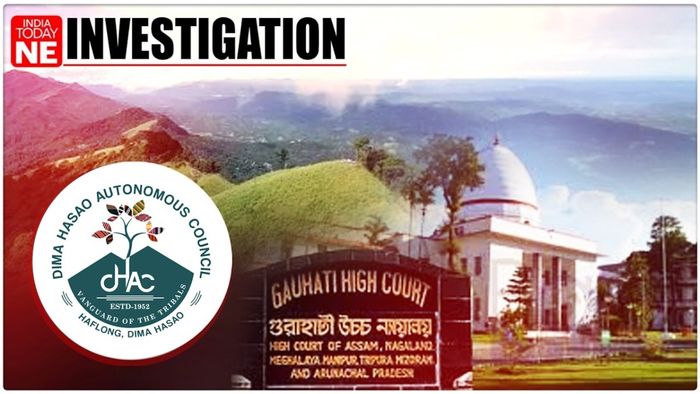Why a 3,000-bigha land transfer to a cement company sparked a Gauhati High Court judge’s ire
A cement plant project in Assam’s Dima Hasao spiraled into one of the state’s fiercest land disputes, marked by forced acquisition, gunfire, and an alleged 48-crore compensation scandal. Villagers allege betrayal, while a Gauhati High Court case now tests tribal land safeguards.

- Aug 24, 2025,
- Updated Aug 24, 2025, 10:32 AM IST
In the remote hills of southern Assam, where tribal communities have lived for generations, bulldozers arrived in July last year with a simple message: your land no more belongs to you. What followed—gunfire, protests, and a Rs 48 crore alleged compensation scandal—has exposed the dark underbelly of industrial development in India’s protected tribal areas.
At the heart of the dispute is a proposed cement plant in Assam’s Dima Hasao district, which borders Manipur and Nagaland. The transfer of 3,000 bighas of land to Mahabal Cement Private Limited, acquired in February 2024 by JK Lakshmi Cement of the New Delhi–based JK Group, has triggered one of Assam’s most contentious land disputes in recent years. What began as a development project has morphed into a saga of forced land acquisition, intimidation, gunfire, and a courtroom drama now being played out in the Gauhati High Court.
The sheer scale of the acquisition stunned even the Gauhati High Court, where Justice Sanjay Kumar Medhi exclaimed during an August 12 hearing: “3,000 bighas! The entire district? What is going on? A private company being given 3,000 bighas?” The viral video of Justice Medhi’s incredulous questioning thrust this remote dispute into national headlines, initially sparking confusion when social media users and political parties, including the Congress, mistakenly linked the project to the Adani Group, a connection the conglomerate swiftly denied on August 18.
Dima Hasao operates under India’s Sixth Schedule, constitutional provisions designed to protect tribal populations by giving autonomous councils control over land and resources. The Dima Hasao Autonomous Council (DHAC), entrusted with safeguarding tribal interests, approved the massive land transfer to the cement company in two phases: 2,000 bighas in October 2024, followed by an additional 1,000 bighas the next month.
The proposed factory site, nine kilometres from Umrangso town, encompasses two inhabited villages—Nobdi Longkukro, home to the Dimasa community, and Choto Larpheng, populated by Karbi villagers. At the August 12 Gauhati High Court hearing, Mahabal Cement claimed the land was “barren and unused”. The residents, however, tell a starkly different story.
The trouble began in mid-2024 when DHAC summoned villagers to what officials called a public hearing. According to local sources, there was no discussion, only an announcement that their land would be taken in exchange for compensation. The largely uneducated villagers, caught off-guard and uninformed of their rights, initially acquiesced.
The compensation structure soon revealed itself as a cruel joke. While the council allegedly received nearly Rs 50 crore for facilitating the land acquisition, villagers claim only Rs 2 crore trickled down to them. Individual families received cheques for a mere Rs 2 lakh, while village heads reportedly got Rs 15 lakh.
When residents of Nobdi Longkukro discovered the vast discrepancy, they returned their cheques in protest. On May 16, they submitted a formal complaint to DHAC, alleging “coercion” and “disinformation” in what they called an “involuntary” acquisition.
The situation exploded on July 31, 2024, when officials arrived with bulldozers to begin seizing the land. Mass protests erupted, met with an allegedly violent response from Monjit Naiding, an executive member of DHAC. According to a police complaint filed on October 31 by three local youths—Sonesh Hojai, Somorjit Nunisa, and Subjoyon Jidung—Naiding allegedly snatched a gun from his security officer and opened fire to intimidate protesters. The bullets, they claimed, narrowly missed their mark. Those who continued to voice opposition reported facing abuse and intimidation.
The anger spread to Choto Larpheng, where Karbi villagers also rejected their compensation cheques and launched their own resistance. Local sources suggest Karbi political leaders seized on the unrest to advance their own agendas, further complicating an already volatile situation.
The dispute has now become a full-blown legal confrontation. In August 2024, activist Babojit Langthasa filed a Public Interest Litigation, though the High Court directed him to secure testimonies from affected villagers since he wasn't a resident. By December, villagers themselves had filed a writ petition, which was admitted in January 2025. It was during one of the hearings on August 12 that Justice Medhi’s questioning of the allotment of 3,000 bighas of land to a private company went viral and brought national attention to the case.
Meanwhile, those accused of wrongdoing have denied all charges. Naiding, in an exclusive conversation with India Today NE, dismissed the shooting allegations as “false and baseless”, insisting the acquisition was legal and that villagers had willingly surrendered their land. He claimed ignorance of the High Court proceedings.
Prasant Singha, Mining Head of Mahabal Cement in Dima Hasao, similarly professed “no knowledge” of the land acquisition process, dismissing all allegations as unfounded.
Beyond the claims and counterclaims lies a deeper truth: in Assam’s hills, where tribal land is supposed to be protected, villagers found themselves staring at bulldozers, bullets, and backroom deals. The Dima Hasao dispute is no longer just about a cement plant. It is a test case for whether constitutional safeguards in India’s tribal belts are meaningful, or merely ornamental words in a legal document.
(With inputs from Jitu Das)